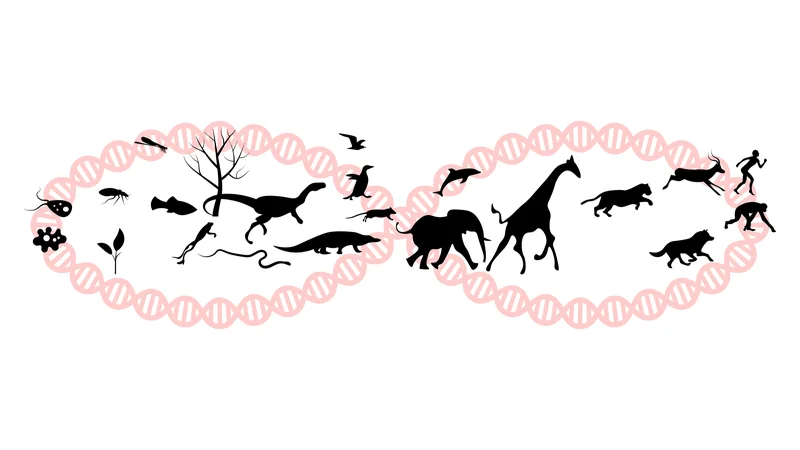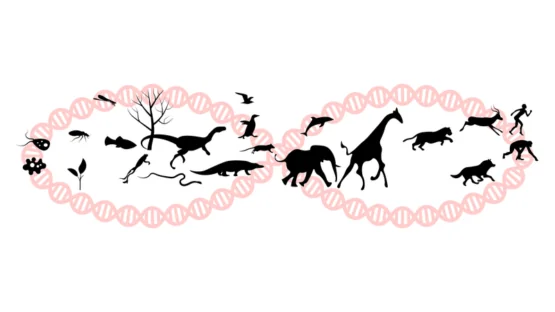In a paper in Frontiers in Genetics, Maël Lemoine of France’s CNRS offers an evolutionary perspective on the hallmarks of aging [1]. This review examines the appearance of the hallmarks in different groups across the tree of life, with the aim of providing a comprehensive picture of how the mechanisms of aging have evolved. With this in hand, longevity researchers would have a better framework for contextualizing their findings, and an evolutionary perspective could also be valuable in guiding which hallmarks would best reward research efforts with effective interventions.
General theories
The evolutionary biologist Theodosius Dobzhansky once wrote an essay entitled “Nothing in Biology Makes Sense Except in the Light of Evolution,” and that sentiment has become something of a tenet among evolutionary biologists and perhaps even among biologists more broadly. Despite the undisputed centrality of evolutionary processes to our understanding of biology, evolutionary biology has remained peripheral to longevity research.
There have been broad theories about the evolution of aging. For example, Medawar’s hypothesis proposes that mutations that affect organisms later in life are progressively ‘invisible’ to selection because the organism will already have reproduced by the time the mutation’s deleterious effects come into play. Another theory, antagonistic pleiotropy, proposes that some traits could be beneficial in early life and deleterious in later life. Finally, the disposable soma theory suggests that a trade-off between reproduction and repair underlies aging. While these ideas offer a broad framework for the evolutionary ‘why’ behind aging, they don’t address the evolutionary appearance of aging – that is, when aging or aspects of it first appear in the evolutionary record.
Lemoine set out to do just that. He uses the hallmarks of aging published in 2013 as his framework, but instead of keeping the nine hallmarks from the paper, he breaks them down into 20 more specific hallmarks. He then tracks the appearance of these hallmarks across the tree of life, using a phylogenetic tree published in a 2010 study of cancer genes. His goal is to find the earliest groups that exhibit each of the hallmarks, which allows him to infer the order in which the hallmarks evolved.
A more precise progression
According to Lemoine, the earliest hallmark to appear is loss of proteostasis, which he reports is present in prokaryotes. This is based on the fact that aggregated proteins seem to increase the chance of a bacterium dying. The aggregates are unevenly allocated during cell division, partitioning the damage between the daughter and mother cells.
The same approach is used to pin down the order of the other hallmarks that Lemoine is studying. Genomic instability seems to be the next to appear, with the common ancestor of archaea and eukaryotes apparently having histones and chromatin to help structure their DNA – though Lemoine notes that there isn’t currently any evidence that either is involved in archaeal aging.
This highlights an inevitable challenge of such an ambitious project. In many cases, components of a mechanism of aging are present, but there isn’t any evidence that these components are involved in aging, often because there hasn’t been any research on that question. Lemoine notes this clearly and nevertheless continues through the tree of life, adding hallmarks as he makes his way towards bilaterians, mammals, and humans. It’s interesting to see that hallmarks such as the accumulation of mutations and the shortening of telomeres are the most recent to have evolved, appearing only in bilaterians.
Though all of the hallmarks have appeared in bilaterians, Lemoine points out that more specific hallmarks exists in narrower groups. For example, he points out that human aging is characterized by a reduction in the repertoire of T cells, a very specific hallmark that applies only to a narrow evolutionary group.
The end result of this research isn’t just a list of hallmarks appearing in a particular order. Lemoine discovered that the hallmarks could be divided into two groups based on when they appeared, which he calls unicellular and metacellular. The unicellular hallmarks are involved in the aging of individual cells, whereas the metacellular hallmarks underlie the aging of multicellular organisms. A key finding is that the earliest multicellular organisms to appear are not senescent. They solved the problems of unicellular aging by renewing tissues and are simple enough in structure that the metacellular hallmarks don’t pose a significant problem.
Abstract
The evolutionary theory of aging has set the foundations for a comprehensive understanding of aging. The biology of aging has listed and described the “hallmarks of aging,” i.e., cellular and molecular mechanisms involved in human aging. The present paper is the first to infer the order of appearance of the hallmarks of bilaterian and thereby human aging throughout evolution from their presence in progressively narrower clades. Its first result is that all organisms, even non-senescent, have to deal with at least one mechanism of aging – the progressive accumulation of misfolded or unstable proteins. Due to their cumulation, these mechanisms are called “layers of aging.” A difference should be made between the first four layers of unicellular aging, present in some unicellular organisms and in all multicellular opisthokonts, that stem and strike “from the inside” of individual cells and span from increasingly abnormal protein folding to deregulated nutrient sensing, and the last four layers of metacellular aging, progressively appearing in metazoans, that strike the cells of a multicellular organism “from the outside,” i.e., because of other cells, and span from transcriptional alterations to the disruption of intercellular communication. The evolution of metazoans and eumetazoans probably solved the problem of aging along with the problem of unicellular aging. However, metacellular aging originates in the mechanisms by which the effects of unicellular aging are kept under control – e.g., the exhaustion of stem cells that contribute to replace damaged somatic cells. In bilaterians, additional functions have taken a toll on generally useless potentially limited lifespan to increase the fitness of organisms at the price of a progressively less efficient containment of the damage of unicellular aging. In the end, this picture suggests that geroscience should be more efficient in targeting conditions of metacellular aging rather than unicellular aging itself.
Conclusion
This is both an ambitious effort and a valuable contribution. While there can doubtless be quibbles about specific details, the overall idea is worth pursuing, and the resulting framework enhances our understanding of aging biology. A key takeaway that Lemoine highlights is the division between unicellular and metacellular hallmarks. According to this framework, because the metacellular hallmarks are the main drivers of aging in many multicellular organisms, research that targets the processes behind the aging of individual cells is less likely to increase our longevity than research that targets the processes behind the metacellular hallmarks.




